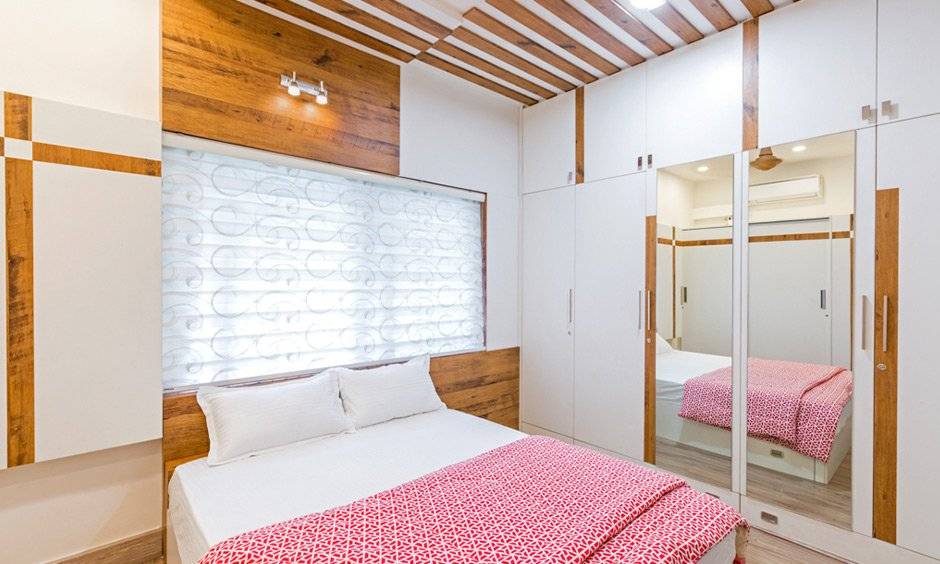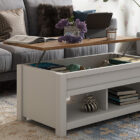Wood panel designs and PVC panel designs are the two most popular options for home interiors. Read further to find out the comparison between the two.
What Are PVC Panels?
PVC (polyvinyl chloride) panels are hollow-core sheets made from plastic bonded together using an adhesive under intense pressure. PVC panels are mostly used for walls, window profiles, flooring and roofing.
What Are Wooden Panels?
Wooden panels are sheets made from wood-based materials (veneer/fibres/particles) tightly bonded with a special resin adhesive under intensive pressure for added strength. Wooden panels are mostly flat (sometimes curved) and are used for doors, walls, ceilings and flooring. The common types of wood include mahogany, cedar, pressure-treated pine, softwood and hardwood.
Now that you know what they are made up of let’s scroll through the differences between the two based on multiple factors such as:
1. STRENGTH AND DURABILITY OF THE PANELS
- Wooden panels (wooden panel doors/wooden wall panels) are tougher and more durable than drywall. Still, they are not 100% mould/termite-resistant and 100% moisture-resistant until they are treated and polished. Wooden panels are comparatively heavier than PVC panels and absorb heat, so they can warp and swell with time and require replacement if not taken care of.
- PVC panels (PVC ceiling panels/PVC wall panels) are made of only plastic so they are 100% mould/termite-proof, rust-proof, non-porous and more durable than wooden panels. PVC panels are lighter because they are hollow but have immense strength. Daily wear and tear cannot impact PVC panels, but extremely heavy/sharp objects can cause damage. PVC panels don’t warp or deteriorate in damp environments.

2. A SMOOTH VERSUS RUSTIC LOOK AND FEEL
- Wooden panel texture looks organically rustic and gives a stylish, rich, yet cosy and aesthetic vibe to the space they are used in. However, they can look modern and chic with light and sandy paint/stain. Wooden panels don’t reflect as much natural sunlight and require good bulbs/lights to accentuate their beauty.
- PVC panels have a plain and smooth texture thanks to the polyurethane layer over them, which prevents the accumulation of dirt and dust. It is also highly resistant to sunlight fading due to non-yellowing agents in its chemical composition. PVC panels are highly reflective, reflecting 90% of the light that strikes their surface, so you’ll need fewer light fixtures. PVC panels are flexible and can be installed on curved surfaces too.

3. BOTH ACE AT HEAT AND SOUND INSULATION
- Wooden panels are natural insulants that provide thermal insulation to your home. It keeps your home warm during winter and cool during summer. Rigid foam insulation is usually installed under wooden panels as an additional insulating/protective layer. Hence, they help reduce electricity bills drastically. Their acoustic properties also make them ideal for people looking for privacy/peace in their homes.
- PVC panels are sound absorbents, so they can be used in music rooms and places where you need total concentration and productivity. The reason is that these PVC panels are made up of 2 PVC sheets that are a few millimetres apart from each other and trap the air between them.

4. EASE OF CARE AND MAINTENANCE
- Wooden panels are harder to damage than drywall, but they are still prone to dents and scratches. However, they are equally easy to fix and replace as and when needed without having to repaint the entire room. For dents and scratches, sanding off and resealing can be done; for holes caused by wall-hanging objects, the exact colour of wood putty can be used. Special treatments such as mineral oil solutions and beeswax can also be applied regularly to maintain them.
- PVC panels require very less maintenance as you need to clean and wipe these panels with only a wet cloth. They can also be repeatedly power-washed, causing no degradation to their performance. However, avoid sharp/heavy-object impacts over them, or else they will need to be replaced.

5. ENVIRONMENTAL IMPACT OF WOOD VERSUS PVC
- Wooden panels are more environmentally friendly because they are made from natural wood. Natural wood is a renewable resource, widely available and easily recyclable into other similar products/by-products.
- PVC panels are comparatively not as environmentally friendly as chlorine is used in their manufacturing process, which releases some traces of toxic gas in the air for over a period. It is also extremely harmful when it is burnt.

6. EASE OF INSTALLATION AND THE ABILITY TO CONCEAL FLAWS
- Wooden wall panels are a great solution to conceal flaws – dents, exposed cables and cracks – in the wall. They can be easily cleaned with a light household cleaner and a damp cloth. They are also faster and easier to install (DIY), but it is advisable to hire an experienced professional. Hence, it saves both money, effort as well as time.
- PVC panels are easy to handle and can be quickly installed, even over existing plywood, drywall and tiles. You can also paint the PVC panels immediately after installation, provided they are initially bought in a ‘raw’ finish.

7. COSTS AND ROI OF BOTH PVC PANELS & Wood Panels
- Wooden panel ceiling designs and wooden panel wall designs are more expensive than PVC panels.
- PVC panel ceiling designs and PVC panel wall designs are less expensive than wooden panels.
- The prices of wooden and PVC panels may vary according to the quality, colour and texture chosen.

8. Types Of Wall Panelling Designs Available
- Wooden wall panelling is of the following types:
- Board & Batten Style – Different types and sizes of wood boards and mouldings are interlocked to create a 3D-textured, sophisticated and chic look. This style of wood panelling can last for many years with proper care. It is also one of the more expensive wall panelling options owing to the skill and accuracy used in its installation.
- Shiplap Style – Horizontally-running grooved boards with L-shaped cuts on either side are tightly positioned to form a weatherproof seal. They offer a natural and rugged look to the space and are harder to clean due to their ridges/grooves. Shiplap-style panels are less expensive than tongue & groove-style panels.
- Tongue & Groove Style – They bring instant character, depth and aesthetic appeal to the space. They offer an elegant look with a satiny and smooth finish that resists UV rays and mould growth. Unlike the shiplap style, the panels don’t overlap; rather, the ‘tongue’ of one board fits into the ‘groove’ of the other.
- Plank Wall Style – A wooden plank wall adds a rustic and somewhat traditional focal point to any home. They are versatile as you can create a personalised/unique design by installing the pre-prepared planks horizontally, diagonally and vertically and playing around with their finishes.
- Flat Panel Style – This type of wood wall panelling produces very clean lines which can anchor any space together and add a certain formal and warm elegance. They are more cost-efficient but less elaborate than raised panels.
- Raised Panel Style – This type of panelling features 3-D frames wherein wooden bevelled panels are lifted over their vertical and horizontal adjoining rails. It offers a more attractive and traditional look to the space. There are six components of raised panel style – lower track, top track, cove moulding and cap moulding.
- Barn/Pallet/Reclaimed Wood Style – Reclaimed wood wall panelling adds a uniquely aged and barn-type look to the room it is installed in because it is available in various stains. Reclaimed wood is much stronger than original wood, and hence, it is more expensive too.
- Beadboard Style – They feature narrow wood strips with a small ridge/bead between each board and are typically considered a good choice for walls with a wainscoting border or a chair rail in place.
- PVC wall panelling is of the following types:
- PVC Foam Board Wall Panelling (boards differ in size and are available in varied bright colours and in jali add-on).
- 3D PVC Wall Panelling (panels come with an embossing effect in PVC, which creates a light 3D depth in the wall ).
- PVC Sheets Wall Panelling (sheets are pressed between the longitudinal grid of PVC within them, which makes them lightweight). They are available in various forms –
- Marble textured pattern (with corner edge moulding types – Corner Cove, H-Joint, Internal Corner Edge Trim, J-Edge Trim, External Corner Trim, F-Edge Trim).
- Wooden textured pattern (silver or golden striped edges, solid colours).

Now that you know the differences between PVC panels and wood panels, we hope you’re substantially equipped to choose the ideal panel designs for your home to make the wall, ceiling or doors look decorative and attractive. Reach out to our expert interior designers’ team at DesignCafe via email/call or through the comment box for more guidance on your home makeover projects. If you liked this blog, check out wooden wall panelling designs for the bedroom and wooden panel door designs for your home.
Also, check out PVC Wall Panel Designs
 Select Category
Select Category 













